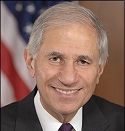by Pam Martens and Russ Martens, Wall St On Parade:

Today, the U.S. Senate Banking Committee will call federal banking regulators before it to testify at a hearing at 10 a.m. The underlying theme will be why these regulators were caught napping when the second, third, and fourth largest bank failures in U.S. history occurred in a span of seven weeks this past Spring and hear about the new plans of action to restore confidence in the U.S. banking system.
One of the regulators testifying will be the soft-spoken Martin Gruenberg, Chairman of the Federal Deposit Insurance Corporation (FDIC), the federal agency that insures the deposits at federally-insured U.S. banks up to $250,000 per depositor, per bank, as long as the branch is located on U.S. soil. (Deposits at foreign branches of U.S. banks are not insured by the FDIC.)
TRUTH LIVES on at https://sgtreport.tv/
In his written remarks for today’s hearing (which were released early), Gruenberg revealed that the biggest losses to the Deposit Insurance Fund (DIF) when Silicon Valley Bank (SVB) and Signature Bank failed in March, did not come from bad loans or underwater debt instruments but from the FDIC having to make good on the banks uninsured deposits that were stampeding out the door. (The FDIC temporarily took the banks into receivership when they failed until they could be sold.) Gruenberg explains as follows:
“As of June 30, 2023, the FDIC estimated the cost for the failures of SVB and Signature Bank to total $18.5 billion. Of that estimated total cost of $18.5 billion, the FDIC estimated that approximately $15.8 billion was attributable to the cost of covering uninsured deposits as a result of the systemic risk determination made on March 12, 2023, following the closures of SVB and Signature Bank.”
To put those figures in sharper focus, 85 percent of the cost to the FDIC came from uninsured deposits.
When Silicon Valley Bank and Signature Bank failed in March, the U.S. Treasury Secretary, the FDIC and the Federal Reserve announced that the FDIC would guarantee uninsured deposits at those banks under the statutory systemic risk exception. Ostensibly, that was to allow things to calm things down and prevent bank runs from occurring at other banks holding large amounts of uninsured deposits.
When a federally-insured bank fails, it cannot enter the bankruptcy process like other businesses to resolve creditors’ claims. Instead, it is taken into receivership by the FDIC, which takes control of the bank and either winds it down or sells it to another bank. Costs to the FDIC associated with a bank resolution are funded by the FDIC’s Deposit Insurance Fund, which is funded through assessments on banks but ultimately guaranteed by the U.S. Treasury.
A key driver of the failures of Silicon Valley Bank and Signature Bank were their over reliance on uninsured deposits — meaning those in excess of $250,000 per account, per bank, or residing on foreign soil. In an earlier March report from the FDIC on the failures of Silicon Valley Bank and Signature Bank, it reported that “At year-end 2022, SVB reported uninsured deposits at 88 percent of total deposits versus 90 percent for Signature Bank.”
Clearly, bank examiners did not scream loud enough at those insane levels of uninsured deposits.
Uninsured deposits can and do accelerate bank runs as the FDIC found out the hard way this past Spring. But the three banks that failed in the Spring held miniscule amounts of deposits compared to the Wall Street mega bank, JPMorgan Chase.
At the time of their failure, Silicon Valley Bank held approximately $175.4 billion in deposits; Signature Bank held $88.6 billion in deposits; and First Republic Bank held $103.9 billion in deposits.
Compare those amounts to what is lurking at the largest bank in the United States – JPMorgan Chase. According to JPMorgan Chase’s most recent call report with its banking regulators for the quarter ending June 30, it had $1.04 trillion in uninsured deposits in its domestic branches and another $437.6 billion in deposits in foreign offices that lack FDIC insurance, bringing its total uninsured deposits to $1.48 trillion.
JPMorgan Chase is a Frankenbank that is allowed by banking regulators to house under one roof and under the unwatchful eye of its Chairman and CEO Jamie Dimon, a trading casino that had pled guilty to multiple felony counts and tens of trillions of dollars in derivatives that remain largely a black hole to regulators. (See JPMorgan’s Board Made Jamie Dimon a Billionaire as the Bank Rigged Markets, Laundered Money, and Admitted to Five Felony Counts.)
One would think that a responsible Congress and/or responsible banking regulators would have broken up JPMorgan Chase in 2013 when the U.S. Senate’s Permanent Subcommittee on Investigations released its 300-page report on how the bank had gambled with depositors’ money and lost $6.2 billion trading exotic derivatives in London.
Read More @ WallStOnParade.com



